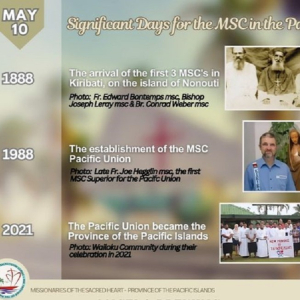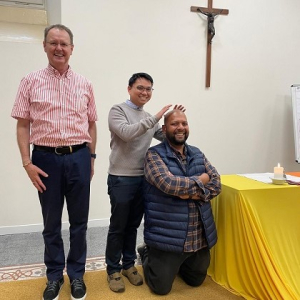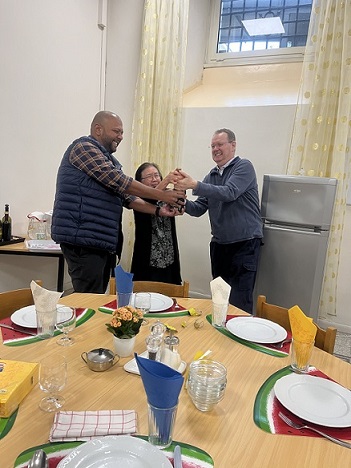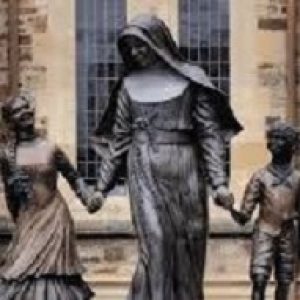Peter MALONE
Significant Day for MSC Pacific, My 10th, celebrated last Friday
Significant Day for MSC Pacific, My 10th, celebrated last Friday
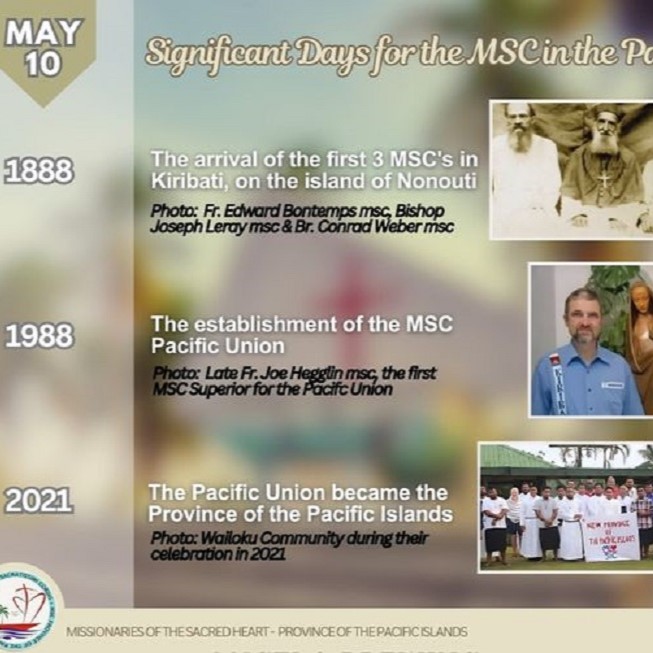
From the message of the former Provincial Superior, Fr Tamati Sefo MSC:
"The 10th of May is a significant date for us for it was on this date in 1888 that the first Missionaries of the Sacred Heart from France arrived in Nonouti in Kiribati. We are grateful to God for their faith and courage for coming halfway around the world to spread the love of the Sacred Heart which they did with great enthusiasm and conviction. And so it is with deep gratitude to the French province for having sent these first missionaries to us.
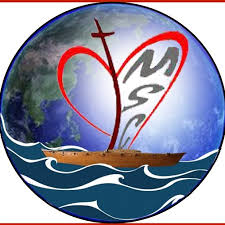
Today we are celebrating the erection of our province all because of their hard work, commitment and faithfulness to the Mission of our Lord. The untiring work of the first missionaries throughout all these years was rewarded when the MSC Pacific Union was erected on 10 May 1988. The late Father Joe Heggelin was the first Union Superior followed by subsequent Union Superiors and their Councils. With their gifts and talents, they have led and guided the Pacific Union with passion and determination.
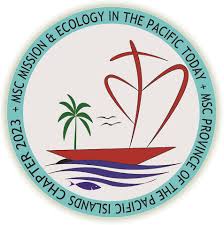
Today I want to acknowledge their wisdom, hard work, and foresight in paving the path for us. Today is a celebration of their hard work over the years of preparing us to become a Province." (11th of May, 2021)
And in 2024
Six aspirants from Kiribati have just arrived in Fiji and settled in Wailoku to start their aspirancy program. There are more aspirants yet to come from other islands. Keep them in your prayers as they discern their vocations.
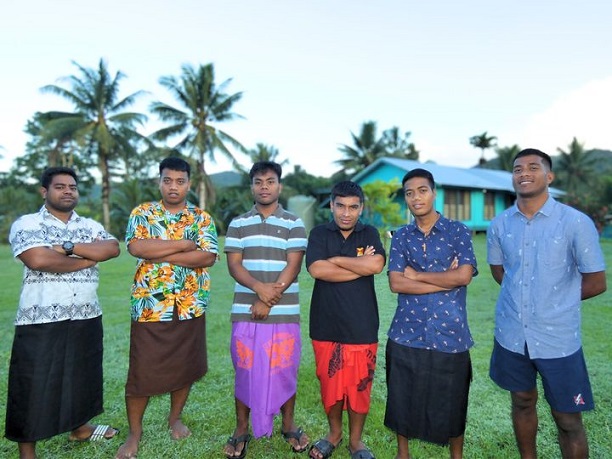
From left: Tiinou, Neneia, Betero, Maiawa, Bakama and Borerei.
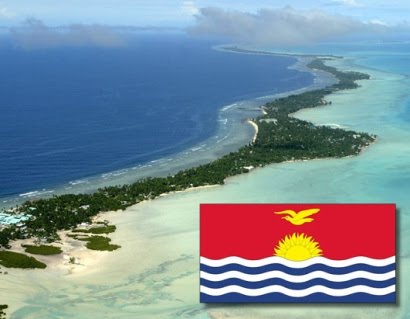
Training in the Practice of Group Facilitation, Course in Rome
Training in the Practice of Group Facilitation, Course in Rome
A longer weekend post, story and many photos - thanks for photos, Chung and Peter, for texts, Peter and Chris.
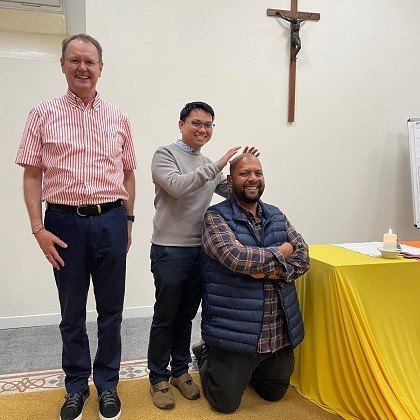
Our participants, Peter, Chung and Kimi - obviously an occasion of blessing
Peter Hendriks writes:
Training in the Practice of Group Facilitation is a 10-week course with eight weeks being online and two weeks being an intensive practicum with the participants gathering in Rome. We've just finished the intensive and have three more weeks of the online course remaining.

The intensive was a practicum to develop our skills in facilitating groups. There are many styles of facilitation, many methods, and modes. An important one for the MSC, which was given a fair deal of focus, was the communal discernment based on Brian Gallagher's book on Communal Wisdom.
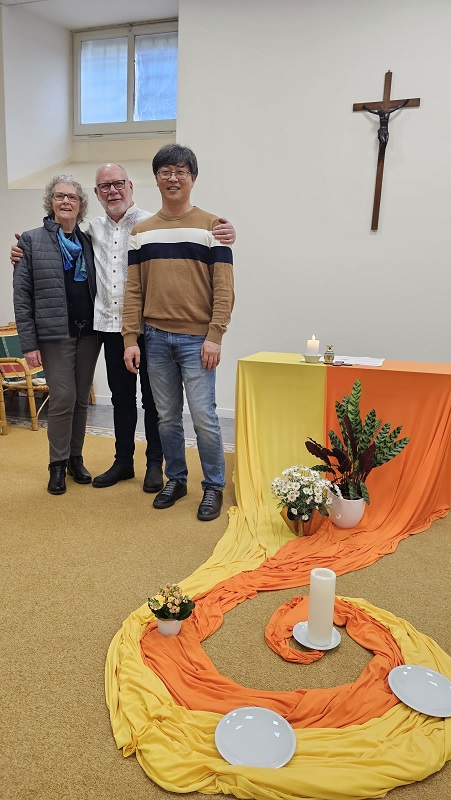
Facilitators, Chris, Carol, Ireneo
There were 12 participants on the course, with two MSC Assistant Generals, three members of the FDNSC leadership team, including their Superior General, three from Brazil, including a laywoman, one from South Africa, and three from Australia/Vietnam.
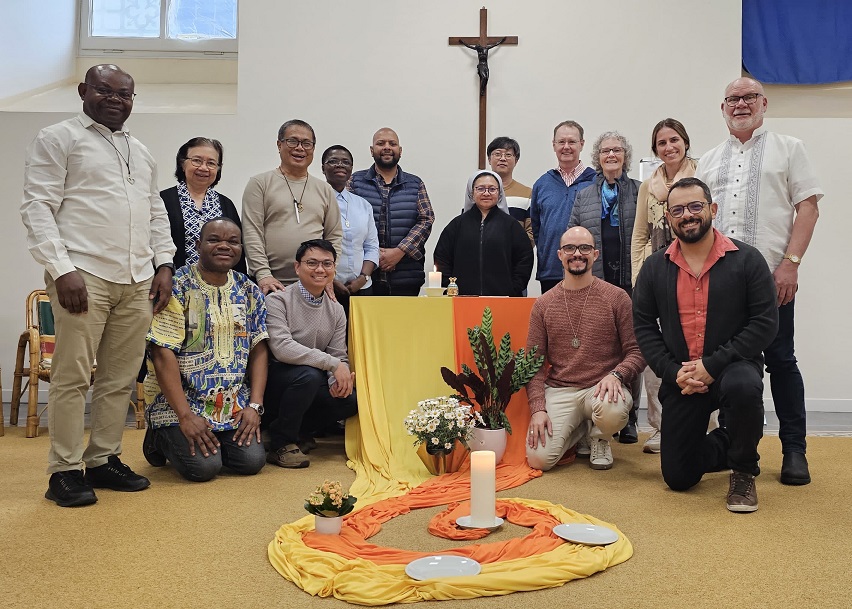
A vital skill for a facilitator is to be aware of the movements within him or herself. This assists in preventing their own issues from interfering with their role, and it can also be an indicator of what is happening within the group.
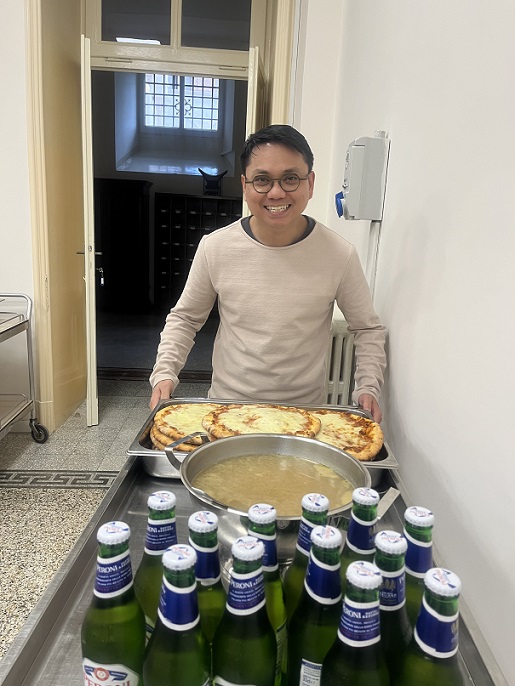
The 3 Brazilians will assist Chris Chaplin with the Spanish-speaking version of the course, which will commence in the second half of the year.
MSC and OLSH work together in challenging situations
Chris Chaplin, Course facilitator writes on the aims of the course. Writes
The current batch Trainees participating in the English language, MSC Ongoing Formation, Training in the Practice of Group Facilitation, met in Rome recently (April 21-May 3) for their two-week face to face practicum. The practicum experiential learning Module is a central aspect of the fourteen-week training together with twelve weeks of online learning. Each of the 8 online Modules have 5 Units (or Lessons) of theoretical input (video clips, reading, research) with online exercises to be submitted. Trainees also join an Online Learning Community with peers for review of facilitation challenges, and have a weekly accompaniment session with their designated Trainer. Trainees include MSC, FDNSC, and lay members of the Chevalier Family.
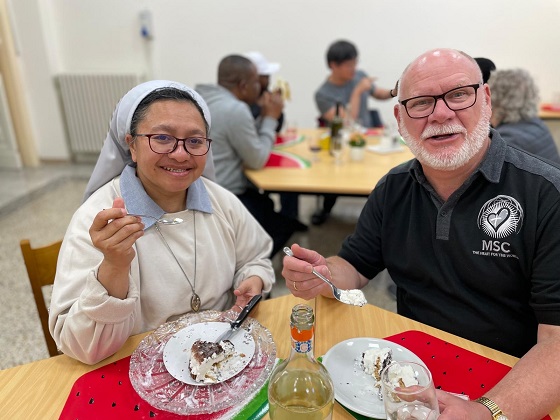
The aim of the program is to train participants in the practice of group facilitation. It is especially for those in leadership and leadership teams who want to learn skills in facilitated accompaniment; for formators working to empower formandi in the journey of self-discovery and motivation for mission; for those interested in enabling others by connecting them to their own inner passion; for those wishing to gain skills in the facilitation of Communal Wisdom discernment; and for those working in the ministry of ongoing formation, workshops, retreats, etc.
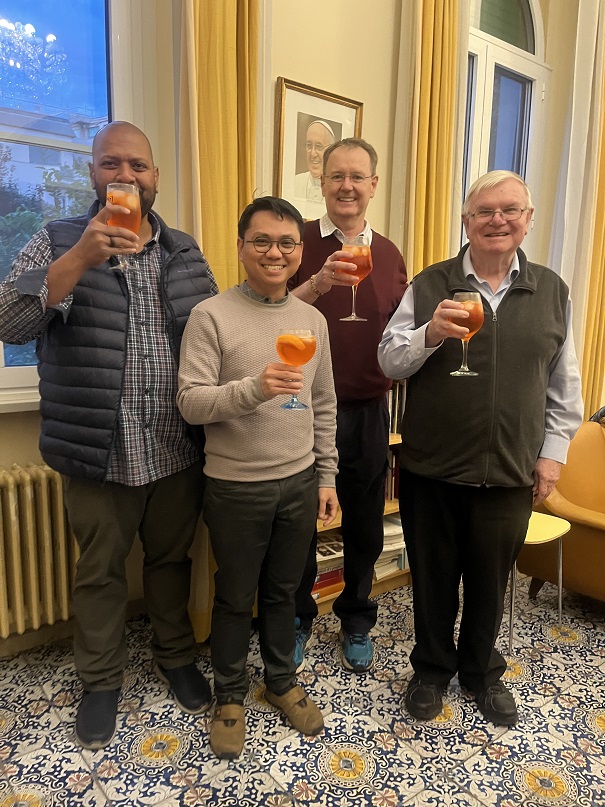
It is expected that participants will complete a standard of training that enables them to competently commence practice as a facilitator. The training has been given professional recognition by the MSC General Conference. We hope to grow in those who participate in this training a sense of the importance of their own competence and capacity to facilitate process-oriented facilitation that is deeply rooted in Heart Spirituality, and to grasp the significance of discernment, accompaniment, and self-discovery, in group facilitation (enabling Formation of the Heart). Furthermore, we aim to develop networks of facilitators who are able to support each other as peers and are competent in coordinating and facilitating within their own organisations, at home and internationally.
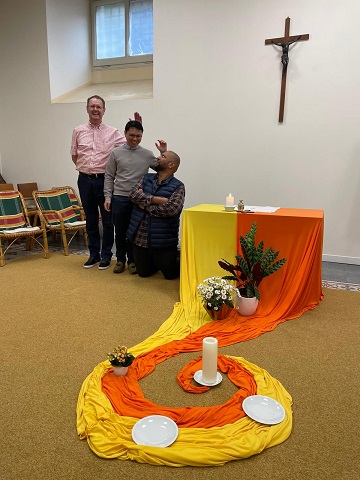
So, in facilitation, height is not significant
The English language program finishes in early June. The Spanish/Portuguese language version of the Training begins in late June, with a practicum in Juiz de Fora, Brazil.
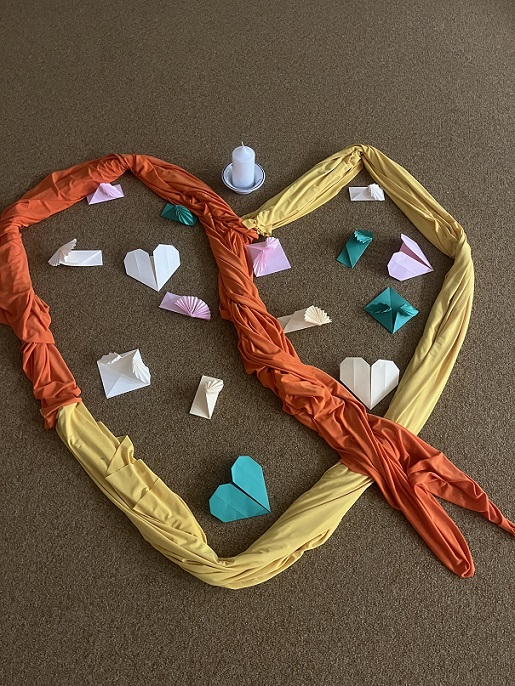
Daramalan College Alumni, achievement with the Daramalan MSC spirit.
Daramalan College Alumni, achievement with the Daramalan MSC spirit.
Over the years, the Daramalan Alumni Facebook page chronicles some of the ex-student achievements. We have posted quite a number of these stories – a tribute to the MSC spirit in education.

Justice Jeremy Kirk
After 20 years practising as a barrister in Sydney, ex-Dara lad Jeremy Kirk from 1987, (brother of Tim “Clonakilla” fame) will be sworn in as a judge to serve in the NSW Supreme Court, the highest Court in the state. He will sit in the Court of Appeal, described by the Attorney General Mark Speakman as, “the strongest state or territory appellate court in Australia”. Well, what more can you say, except huge congratulations Justice Kirk.
_______________________________________
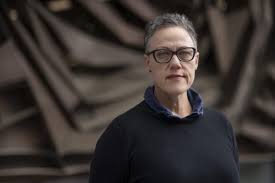
Brenda Croft from 1981, currently a leading First Nations artist and scholar from the ANU, has been awarded the Gough Whitlam and Malcolm Fraser Chair of Australian Studies at Harvard University for the 2023-2024 academic year. Yep, THAT Harvard, America’s oldest and most prestigious University. The award will see her as the inaugural First Nations woman to take up the role. Impressive!
Brenda is from the Gurindji/Malngin/Mudburra peoples from the Northern Territory, with Anglo-Australian/ Chinese/German/Irish heritage. Her new role will see her teaching and researching between the Department of History of Art and Architecture, and the Department of Art, Film, and Visual Studies, while also engaging with colleagues in the Harvard University Native American Program.
Brenda recently completed her PhD and is now Professor Croft at the ANU College of Arts and Social Sciences. The Dean of the College, Professor Rae Frances stated, "We are especially proud to be represented by such a talented Indigenous scholar whose work will do much to communicate the rich culture and history of Australian First Nations people to a US audience.
________________________________
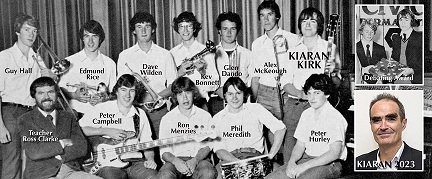
Recognised in the Australia Day Honours List, Professor Kiaran Kirk (1979), appointed a Member of the Order of Australia for his significant service to science education and research. Kiaran, brother of Tim Kirk (1984) of Clonakilla fame, is Dean of the ANU’s College of Science with his primary research interest being the biology of the malaria parasite.
A long way from his interests at school which included Jazz/Rock music and Debating, with his team winning the 1979 Inter-Schools Debating Trophy. Kiaran even took home a new watch for his efforts. 43 years later he has an Order of Australia medal to go next to that watch on the mantlepiece.
______________________________________
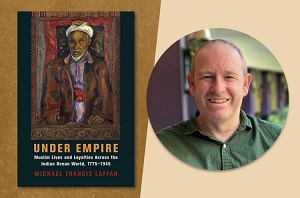
An amazing achievement by our 1987 graduate Michael Laffan, whose book "Under Empire" won the General History Prize in the 2023 NSW Premier's History Award (a bit late but still amazing!). The General History Prize is given to a major work of non-fiction, on international history that is of national or international significance. The book tells about shifting perceptions of Muslims in Indian Ocean empires from the Dutch to the British, Ottomans and, at the close, Japanese.
Michael is currently Paula Chow Professor of International and Regional Studies; Professor of History; Director of the Center for Collaborative History at Princeton University.
___________________________________
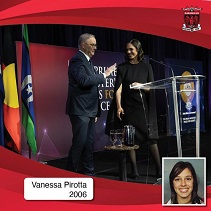
Award-winning wildlife scientist and 2006 Daramalan College Alumna, Dr Vanessa Pirotta, hosted the 2023 Prime Minister’s Prizes for Science at Parliament House. Guests from across the Australian science, research, technology and education community attended the presentation dinner and Anthony Albanese, Prime Minister of Australia and the Hon Ed Husic, Minister for Industry and Science announced the recipients.
_________________________________________________________
Prayer request:- in solidarity with men who have shared some of their lives with us.
Prayer request:- in solidarity with men who have shared some of their lives with us.
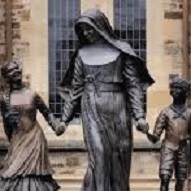
Denis Kelly, a former MSC and a nephew of the deceased confrere, Bishop Edward Kelly MSC, has been diagnosed with fairly aggressive jawbone cancer. His wife Sue, and his adult children, Joseph and Marguerite, have begun a novena for Denis that started on the 5th May. While it has already begun they would sincerely appreciate people joining now.
The novena prayers are directed to the intercession of Mary MacKillop.
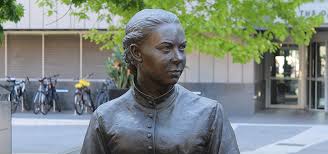
Denis was in the novitiate of 1968 with Bob Mitchell, professed at the beinning of 1969 and then spending some years of study at Sacred Heart Monastery, Canberra.
Wild Indian
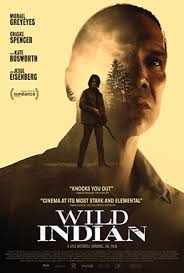
WILD INDIAN
US, 2021, 90 minutes, Colour.
Michael Greyeyes, Chaske Spencer, Jesse Eisenberg, Kate Bosworth, Phoenix Wilson, Julian Gopal, Scott Haze.
Directed by Lyle Mitchell Corbine Jr.
Wild Indian is a brief film focusing on Native Americans, a Native American writer-director, while Mitchell Corbine Jr, the two central men in the narrative, Michael Greyeyes and Chaske Spencer. There is support from white actors, Jesse Eisenberg and Kate Bosworth.
The film is in two parts. It opens with two boys, around the age of 12, at school, their families, friendships, disputes, one boy, Mak’wa, coming from a troubled family, and his friend Teddo, involved in a fatal sequence where Mak’wa shot a young boy.
The narrative then skips a generation, Mak’wa in California, calling himself Michael, wife, business success. By contrast, Teddo has been involved in petty crime, drugs, spent most of his time in jail.
The drama shows Teddo having some kind of remorse, wanting to seek out Mak’wa for some kind of resolution, Michael now resisting the situation, violent towards Teddo with some dire consequences.
While the plot is interesting in itself and the contrast between the two boys and their young lives and their success of lives, it is also interesting in the context of opportunities for Native American boys in the 1980s – and their lives and succeeding decades.
- The title? Traditional white American perspectives on Indians, wild? The condescending attitudes, prejudice?
- This film written and directed by Native American, Native American stars, the supporting white stars?
- The prologue, the old Native American, going out into the countryside, the plague? The recurring this theme at the end? Symbolic of k’wa? Symbolic of Teddh?
- 1984, the reservation, the Native American tribes, families, violence and abuse, schools, teachers, the priest, religious supervision, discussions, moral perspectives?
- The story of Mak’wa, his age, his mother giving birth when young, her neglectful attitude, his father, young, brutal? Mak’wa at school, with the priest, in class, his friendship with Teddo, attraction to the white girl, jealousy of the boy attracted to her? Sullen in his attitudes, the authorities? In the countryside with Teddo? The discussions, Teddo and his family? The gun, the shooting of the boy, Mak’wa’s reaction, Teddo’s reaction, the cover-up?
- The move to the 2010s? Audience surprise at what has happened to the two? Mak’wa, becoming Michael, in California, successful, business contacts, discussions of contracts, meetings? Office, clothes, Finance? His wife, child, the fulfilment of the successful American dream?
- Teddo, in jail, being released, drug dealing environments, the years in jail? Getting out, meeting up with his sister, trying to get a job?
- The buildup to the confrontation between the two men, Teddo, his conscience, confessing to the killing of the boy and the cover-up? Tracking down Mak’wa? Going to California, the confrontation between the two men, discussions, conscience issues? Mak’wa and his fears, violence, the gun, killing Teddo?
- The law, the police, investigations, Michael going back home, the encounter with Teddo’s sister, legal aspects, his business future, wife and child, his decisions for his future, to lose himself in this white world?
- The finale, the old man leaving civilisation? Mak’wa, his conscience, stifling his conscience, his future?
Artist and the Model, The/ L'Artista y La Modela
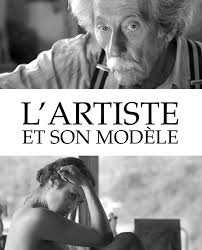
THE ARTIST AND THE MODEL/ L’ARTISTA Y LA MODELA
Spain, 2012, 105 minutes, Black-and-white
Jean Rochefort, Aida Folsch, Claudia Cardinale, Chus Lampreave, Goetz Otto, Martin Gamet.
Directed by Fernando Trueba.
Fernando Trueba has been making films for many decades, in Spain, in France. He intended to make a film about a sculptor in the 1990s, following his brother, but his brother died.
Now, 30 years later, filming in evocative black and white, he tells the story of a sculptor, played by veteran French actor, Jean Rochefort, an icon in French cinema, filming in his early 80s.
The setting is occupied France, a town near the Spanish border. A refuge from Spain, a young girl, chances upon the household, is well received by the artist’s wife and former model, played by veteran Claudia Cardinale, welcomes her, suggesting she might become a model, the young girl initially very hesitant.
However, the film spends a lot of time with the young girl agreeing to pose, wary at first about posing nude, but then many sequences of the artists sketching her, the various poses, her boredom, her responding to the artist requests, effective sketches, then the gradual building up of a plaster statue of her, final success.
There is the background of the war in the town, the German occupies, especially a professor of arts from a German university, visiting the artist, collecting information for a book about him. A complication is that he young resistance man, wounded, has taken refuge in the house, is concealed by the artist and his wife.
The model eventually helps the young man to safety in Spain and then decides that she should move on.
A lot of discussion about art, about inspiration, about having the breakthrough idea, revelations about the psychology of the artist and his creativity, and then the achievement by the artist, his praise of the young model, his seeing his wife off to visit relatives – and then his shooting himself.
A Spanish perspective, a French story, a World War II occupation story.
- The films of the director, over many decades, Spain, France, US? The screenplay, long gestation, Jean-Claude carrier collaborating, the director’s brother being a sculptor but his early death?
- The decision for black-and-white photography, graphic, black-and-white contrasts, the town, the house, the surroundings, the countryside? The modelling sessions, the creation of the sculptures? The musical score?
- The period, occupied France, the Spanish border, the German occupation? The Resistance, live under occupation, normal life? The Germans? The irony of the art professor being an officer, his presence, the visit to the artist, his admiration, collecting material for a book, meeting Maria and Peter, his courtesy? And being transferred to the Russian front?
- The title, the focus on Marc, the artist? The screen presence of Jean Rochefort, his long career, in his early 80s, bringing dignity and credibility to the role? Appearance, age, gaunt, moustache and rather sad face? His wandering, the past with his art, the war bringing a pause? His relationship with his wife, love, long years together, her being a past model?
- Maria, her arrival, her story, Spanish, the aftermath of the Civil War, neutral Spain under Franco? Her ability to move across the border? Her later taking Peter to Spain?
- Her age, personality, no fixed destination, her past, hungry, being seen by the artist wife, her welcome, bringing her home, encouraging her, the possibility of being a model? Maria not understanding what was to be a model, the shock of the removal of clothes? Her agreement? Becoming more and more at home, the meals, posing?
- The visuals of the modelling sessions, the variety of poses, the effect on Maria, fidgety, the demands of Marc, the discussion about having the key idea, his explaining to her the picture by Rembrandt, and her growing understanding and appreciation? His methods, his material, moulding the sculpture, the service of the sculpture, his sketches?
- The effect on Maria, on Marc, on his wife, the completion of the sculpture, her being ready to go?
- The episode with Peter, the resistance, her giving him shelter, Marc agreeing, his recovery from his wound, the tension with the visit of the German professor, Marc giving him some money, Maria taking him to safety?
- Marc, his friend a meal, his artwork, encouragement?
- His wife, going to the sick relative, helping Maria on her way across the border? The farewell?
- Marc, the completion of his work
Clandestine Childhood/ Infancia Clandestina
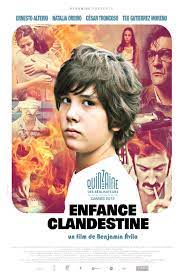
CLANDESTINE CHILDHOOD/ INFANCIA CLANDESTINA
Argentina, 2011, 111 minutes, Colour.
Ernesto Alterio, Natalia Oreiro, Cesar Troncoso, Teo Gutierrez Moreno, Cristina Banegas, Violeta Palukas.
Directed by Benjamin Avila.
An interesting retrospect from 2011 on the years of the rule of the generals in Argentina. There have been many films on these years, on the oppression, on the victims, cruel torture, of the assemblies of the mothers, on resistance.
The story focuses on a strong couple of resistors, extremely staunch, taking refuge at times in Cuba, concerned about their children, especially about the young boy. Eventually, they are able to return to Argentina in the mid-1970s, taking on a new identity, finding a new place, settling themselves in, the boy at school, and the care of a fellow patriot who acts as a kind father figure.
So, the film focuses very much on the boy and his clandestinely childhood, a new name, the relationship with his parents, with the father figure, coping at school, concealing the truth. And there is a visit from his grandmother – and a danger that she will expose the truth.
There are attacks from the authorities, the death of his father figure, the opposition of his parents – and some dire results.
So, the man looks back on his childhood, the political and social situations of his country, his strange childhood and upbringing, his relationship with his family, something that so many Argentinian families had to deal with.
- Based on a true story? Argentina? The post-Peron era, the generals, the oppression, the resistance and revolution? The 1970s, 1975-1979?
- The film as a tribute to those who suffered in this time, revolution, those killed, the harsh administrations, torture? The memories of the writer-director and the final acknowledgements?
- The explanation of the situation, government in Argentina, the military takeover, the oppression, rebels, going into action, refuge in Cuba, the return, living clandestinely, the effect on families, different names, different identities, the gathering of allies, the meetings, the plans, action, and deaths?
- The portrait of the family, the mother and father and their commitment, in Argentina, in Cuba, finding ways of returning to Argentina, separately, mother and baby, father and son? The reliance on Beto? His covering for them? Documentation, setting them up, allegedly from Cordoba?
- The life of the parents, the intensity of the father, absolutely committed, no leeway, humourless? Righteous in his cause? The passion of the mother, story of meeting her husband, their love, commitment? The visit of her mother, the secrecy, the emotion of her mother, wanting them to leave? The dangers? The gathering of the supporters, blindfold, the meetings, decisions? The later action, Beto and his being taken, the grenade, his death? The final action, and the news of the death of the father?
- The focus on the childhood, Juan, his being known as Ernesto, his age, comprehension, his experiences, within the family, with each parent, caring for his sister, the dangers, the hideaway behind the cartons? Going to school, the introduction, the anthem, the issue of the flag, the Beltrano flag, his not wanting to raise the national flag? Settling into the school, with the other children, their acceptance of him, the birthday party, discovering the false birth date on the passport? The parents, the reaction? Beto, his organising everything, his grandmother coming, happiness?
- The boys at the school, their talk, together, eyeing the girls? The gymnastics? Juan and his noticing Maria, her gymnastics, talking with her, the gradual bonding, her comments about her brother?
- Beto, his encouragement, a father figure for Juan? His death, Juan and his memories of his uncle’s encouragement?
- The dangers, finding the money, deciding to run away to Brazil with Maria, meeting with her, her not wanting to leave? His return?
- The final dangers, hiding, the authorities, the interrogation, his declaring his name as Ernesto, concerned about his sister, the bullying of the military, delivering him to his grandmother?
- At his grandmother’s door, his finally saying his own name?
Golda
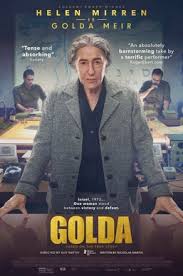
GOLDA
UK/US, 2023, 100 minutes, Colour.
Helen Mirren, Camille Cottin, Liev Schreiber, Henry Goodman, Rami Neuberger, Lior Ashkenazi, Ed Stoppard.
Directed by Guy Nattiv.
Perhaps the title should have been Golda: The Yom Kippur War. Some audiences approaching the film might have been hoping for a full biography/portrait of Israeli Prime Minister Golda Meir. But, it has a particular focus, 1973, the place of Golda Meir in Israel’s history, leadership, the buildup to the war, the attack by Syria and Egypt, how prepared Israel was for the war, responses, strategies, cabinet meetings, decision-making, interactions with the Americans, especially through Richard Nixon’s Secretary of State, Henry Kissinger.
There is some background given throughout the film, the fact that Golda Meir grew up in Ukraine, Jewish family, persecuted by Cossacks. There is mention she has a son. And, during this period, she was quite unwell, in fact, dying in 1978.
There have been many documentaries about Golda Meir but audiences who would like a feature film treatment, there is a 1982 film for television featuring Ingrid Bergman in her last role as the Israeli Prime Minister – and Australian actress, Judy Davis, portraying the younger version of her.
While the film is about the war, there are no re-constructed war sequences. Rather, the film relies on news footage of the period, in black and white, inserted into the discussions throughout the film. And, at some time, inserted are episodes with actual Golda Meir, especially at the end in the discussions about the peace treaty with Egypt and Egypt acknowledging Israel as a nation, the discussions with Anwar Sadat. When Henry Kissinger appears, there is actual footage of him arriving in Israel and the transition to Liev Schreiber with sufficient resemblance.
But, of course, the focus is on Helen Mirren’s performance as Golda Meir, the excellent make-up and prosthetics (Oscar-nominated), then, stances, manner of walking, experiencing her illness, her shrewd assessment of her cabinet, of the tactics of the war, her concern about the dead, a little notebook where she meticulously entered the number of deaths, her visit to the mortuary, her presence when coffins were landed at the airport… Helen Mirren, Oscar-winner for performance as The Queen, is certainly one of the greatest actresses of the time.
The film was released before the Hammas attack on October 7, 2023 – the action of the film going back to 1973, October 5, half a century. There are intimations of the attacks, the range of cabinet meetings and discussions, the role of the hero of the 1967 war, Moyshe Dayan, relied on by Golda that indicating some tremors and health, and there is the adventurous Ariel Sharon, later to be prime minister. And a range of other authorities, the head of Mossad, the head of intelligence, political advisers. On the personal side, there is a continued care and advice of Golda’s assistant, Lou, Camille Cottin.
We watch the details, the succession of days of the war, the strategies, decisions, the attack by Syria and its being repelled, the tactics of Anwar Sadat and the Egyptians, his presumptions of victory, thwarting presumptions, and the continued discussions with the United States, its interests, the oil embargoes of the period.
Audiences watching this film in 2024 will be making comparisons with the Hammas attack, the response of Benjamin Netanyahu and the Israeli government, tactics, bombings, Palestinians in Gaza (not named in this film), the United Nations, numbers of deaths, famine.
- The title and focus, on Golda Meir herself, her role as Prime Minister, 1973, the Yom Kippur War?
- Audience knowledge of Golda, of the war? Older audiences? Younger audiences? Israeli audiences? US audiences? Those outside Israel?
- The film completed before 7 October Hammas attack? Watching this film in the light of the 2023-2024 war? Comparisons? Judgements?
- The focus on the month of the war, initial background information, the state of Israel, the 1967 war, this war 25 years after the establishment of Israel? Attitudes of the Arab countries? The intentions of Syria and the attack? The intentions of Egypt and the attack?
- The portrait of Golda, Helen Mirren’s performance, the look and mannerisms, the make up and prosthetics? Her age, state of health, to hospital, tests, Lou as companion, support, advice, comfort in the difficulties, especially the number of deaths and wounded?
- The portrait of the Israeli advisers, the head of Mossad and his information, the head of security and the later revelation of the listening devices turned off, keeping that secret, the military leaders, Dayan and his past, his advice and success, oncoming illness, Sharon, being aggressive, contrast with David Lazar, “Dado”, the various meetings, discussions, alliances, differences, resolution, Golda listening, making decisions?
- The role of US, the quotes from Richard Nixon, the year of Watergate, the Vietnam war, the role of Henry Kissinger, friendship with Golda, his visit, the phone calls, America’s interests, Arab countries and oil resources, advice, on ceasefire?
- The human interest, the mother at the secretariat and her son being prisoner, the visuals of the captured prisoners, news of his death? Golda, sympathy and comfort? Her listing of the dead in her notebook? The visit to the morgue, the delivery of the coffins at the airport? Her grief, yet tough stances?
- The progress of the war, three weeks, the defeat of the Syrians, the role of the Egyptians, Anwar Sadat? Five years later, Egypt acknowledging Israel, the signing of the treaty, the friendly sequence and the chatter between Golda and Sadat? The lasting consequences of this 1978 agreement?
- The framework of the film, the board of enquiry, Golda’s presence, testimony, the flashbacks, the final judgement?
- And the preponderance of cigarettes and smoking, for 1973, for Golda’s health, or consequent anti-smoking campaigns?
Rest in Peace' Descanser en paz
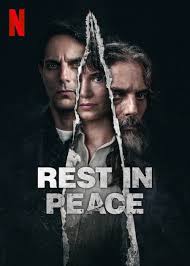
REST IN PEACE/ DESCANSER EN PAZ
Argentina, 2024, 107 minutes, Colour.
Joaquin Furriel, Griselda Siciliani, Gabriel Goity, Lali Gonzalez, Raul Daumas.
Directed by Sebastian Borensztein.
The title is evocative, indicating a death.
This is an Argentinian film directed by Sebastian Borensztein (Chinese Takeaway, Heroic Lives). It features popular Argentinian star, Joaquin Furriel.
The initial setting is 1994, in the Jewish community, the portrait of an owner of a factory, Sergio (Joaquin Furriel) falling on hard times, cheaper imports coming in, his extensive borrowing, the pressure of repaying loans. But he is a genial family man, a devoted wife who has a dental practice, a 13-year-old daughter and the party for Her Bat Mitzvah, a little boy turning seven. With the celebration of the party, the speeches, the daughter praising both parents, what could go wrong? But, there is a sinister presence at the party and Sergio collapses.
There is a revelation then of his business failures, the extent of borrowing, the demands for repayment and ultimatums, the encounter with the main lender, Brenner. There is also a family dispute with one of the members demanding his money back. The couple have not made payments on their daughter’s school fees. Discussions between husband and wife.
With a relative buying the country house, he takes the money to start the repayment when there is an explosion in the Jewish district in Buenos Aires, echoing an actual event of 1994. In the upshot, it almost seems that Sergio could suffer from amnesia. But, fully conscious, he makes a decision to save his family and to disappear – going to the border with the money, crossing to Paraguay, finding employment, successful, the employers getting the new passport and identity.
15 years pass.
His employer had collapsed at Christmas party and died, his wife is in love with Sergio, but a chance encounter at the market with the former maid stirs him again, demanding her silence, his discovering Facebook and seeing images of his family, the boy growing up, the daughter with architectural degree, engaged.
The latter part of the film after showing the happy life of the family in Argentina, debts lifted, insurance, Brenner intervening in their lives, marriage, another child, prosperity, the focus is on the wedding celebration. Sergio leaves Paraguay, goes to the synagogue, discovers Brenner’s relationship with the family. He goes to the party, stirred, seeing the devotion of his children to Brenner, put on a mask, his wife seeing his eyes, then his going into the street, a final confrontation and his death.
For those engaging with the characters, a continued interest but some have commented that the story seems far-fetched and implausible, especially the final sequence. But, it is an intriguing story with sympathetic performers.
- The title and tone? Death? And death? Actual death and consequences?
- From Argentina, Buenos Aires, 1994, families, business? The Jewish community? The Bat Mitzvah celebration? The 1994 bombing and its consequences? Succeeding years in Argentina, prosperity? The contrast with life in Paraguay, shops and work, relationships? The musical score?
- The introduction, Sergio, sympathetic, for Estelita, pride in his daughter, 13, his son, the future? The celebration, the dancing, the cake, Flora and her enthusiastic speech about her mother, her father? The change of tone, Sergio and his speech, the sinister presence, his collapse?
- The revelation of the truth, reluctance to tell his wife, the continued failures of the factory, imported goods, borrowing money, from the lender, from his family, throwing the party, gift for his daughter, the family, Estelita? The selling of the country house? The family dinner, the attack and his saying it was an investment, the family fight?
- Sergio’s visit to the lender, severe, demands, ultimatum? Sergio getting the money,, going to the jeweller, fixing the necklace, been caught in the bomb blast?
- The family, the school, Flora and her fight, her mother going to the principal, the issue of payments? To avoid the interest? Sergio going with the money belt?
- The news of the disaster, Estelita and her going to the site, the interrogations, looking at the photos, the scenes of destruction, of the dead, the wounded, those wandering? The presence of Brenner and the brief interaction? Her not being able to identify any of the photos?
- The transition to Sergio, coming to consciousness, the head wound, getting up, wandering, the treatment, the ambulance? Motivation, getting the bus, to the border, the payment, into Paraguay, a new identity, the friendship with Gordo and his wife, the job, efficient, living quarters, fondness of the dog, his work, not wanting to do with Argentinians? The Christmas gift of the new passport and identity? Gordo as Santa Claus, his collapse, the funeral? At home, the birthday cake for his son, aged seven?
- The passing of 15 years, his appearance, his relationship with Gordo’s wife? His living alone, the dog? His work, reputation? The chance encounter in seeing Beatriz, swearing her to silence? His curiosity about his family, learning about Facebook, going online, the photos of his daughter, fiance, his wife? But not seeing Brenner? The engagement, Flora’s comment about her father?
- The aftermath for Estelita and the family, organising the money and repayments, the factory, the workers? The visit to Brenner, his letting off the debt? Brenner coming to see her at her dental work? His motivations, her response? Indebted, the children growing up, the marriage, another child, the yacht, Flora and her architectural degree, the fiance, the boy, working for Brenner? Time in Estelita’s waiting for news of Sergio, the life insurance?
- Sergio, his decision to go to Argentina, the farewell to Gordo’s wife? His being admired in the town? The journey, his arrival, the contact in Buenos Aires, getting the clothes, the apartment, the gun, the note apologising to a profound him after his death?
- Going to the wedding, the celebrations, in the synagogue, seeing Brenner, his leaving, at the celebration, watching, Brenner and Estelita, the mask, his eyes, his wife seeing him, his leaving, her pursuing him, calling out, the gun, Brenner coming out, the confrontation, the shooting, Estelita comforting him as he died?
- The credibility of the story, the man in debt, the family man, the threats, the accident and his disappearance, a new life, the credibility of his return, the death sequence?
Murdaugh Murders
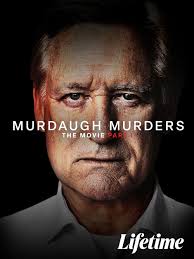
MURDAUGH MURDERS: THE MOVIE
US, 2023, 185 minutes, Colour.
Bill Pullman, Lauren K. Robeck, Curtis Tweedie, Donavon Stinson, Vanessa Walsh, Tanja Dixon-Warren.
Directed by Greg Beeman.
This is a Lifetime production, a recreation of actual characters and events, crime and trials. Adapted for the wide popular audience.
The action takes place from the late 2010s, the crimes at the centre in 2021.
The film introduces us to a South Carolina family, long tradition of lawyers, comfortable living, pride. The focus is on Alex Murdaugh, middle-aged, two sons (one film is never seen but referred to), but seemingly subdued because of his stern father and the tradition of father and grandfather with his legal company. With their place in society, they have quite a lot of influence, connections, favours given, even with judges for places in country clubs…
Alex is married to Maggie, their teenage son, Paul, living at home, the servants, Gloria, drinking heavily, with his friends, and clashing with his father. There are financial difficulties, Alex has an opioid problem, taking money from accounts, getting behind in repayments, and, as the film reveals, making all kinds of payments, pretending to be sympathetic for injury cases but siphoning off the grants.. There are also scenes with him visiting a young woman, a violent sexual encounter.
This all builds up to an evening where somebody in a hooded raincoat shoots his son and his wife, Alex calling the police, the explanations – especially in connection with his son who has been involved in a boating accident with consequent death of a young woman, his being under the influence of drink.
The audience looking at the story makes the assumption that the hooded killer is Alex himself. What follows is police investigation, interventions by the authorities, Alex in denial, playing the macho, but eventually going to court, his use of an expert lawyer to defend him, but his being found guilty. And there are a few complications throughout, even with Alex asking a former client indebted to him to do a bypass shooting and injuring him.
Comments say that Bill Pullman has all the mannerisms of the actual Alex Murdaugh. He is a smooth character on the one hand, and completely unlikable as well. Many praised Bill Pullman’s performance, others not persuaded – and this reviewer had a similar reaction to him and his mannerisms, let alone his denials.
- Screened in two parts on television? Based on actual characters and events? Comment that this re-creation stays close to the facts?
- American audiences, familiar with the case? The impact on the audiences outside the US? The credibility of the characters, the plot, the crimes? The final information about sentencing?
- South Carolina setting, the style of life in the south, reputations, the law and lawyers, John Grisham territory? The lawyers themselves, ethics, long family traditions and pride, influence in society, favours, cutting corners? Reputations, pride, falls?
- Alex and his situation, finance, debts, as wife’s cheques bouncing, his meeting up with his drug supplier, taking of opioids? Other cases, the crippled man, his offer of compensation? The maid and her tripping on the step, her death, allegedly tripping of the dog? The funeral, Alex offering compensation for the family? The series of these sympathetic grants, the long delays, the money not coming through, his being taken to court?
- The revelation of the deals, his associate questioning him, missing money, false accounts?
- The young woman, his attraction, visit to her, the Savage sexual encounter and his injuries?
- Clashes with his son, drinking, the surly attitude of the son, his mother support? Drinking with his friends in Alex’s office, the scope of the opioids, his son’s hold over him? The drinking outing, the girls, the dispute about driving the boat, the crash into the bridge, the girl disappearing and drowning, Paul in denial? Police investigations, Alex and his ambiguous role, his son being charged? Offer of protection, the court, the lawyers?
- The buildup to the killings, the visualising of them, Alex and his reaction, the investigators? The continued investigations, the inconsistencies, Alex and his continued lying, apologies, allegedly visiting his mother, his father in hospital, the carer and trying to force her testimony, her telling the truth in court? The continued backtracking, the episode of the drive-by shooting, the man giving testimony? The issue of looking people in the eye and lying? His practice sessions of absolute love for his family?
- The court proceedings, the prosecution, the artful defence, the jury, guilty?
- The repercussions for Alex, the taking down of his grandfather’s portrait in the court, the prison sequences? Continued denial?
